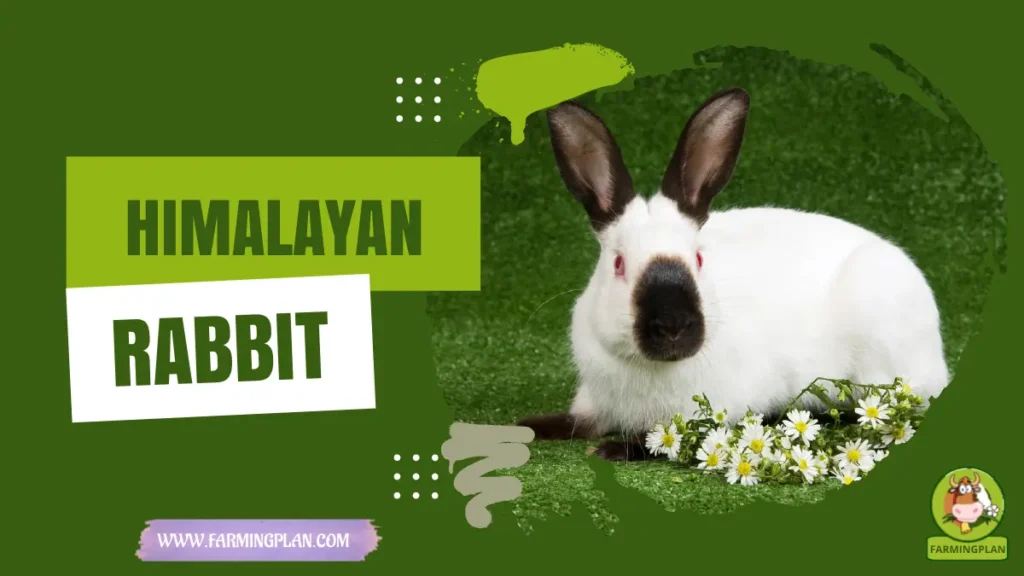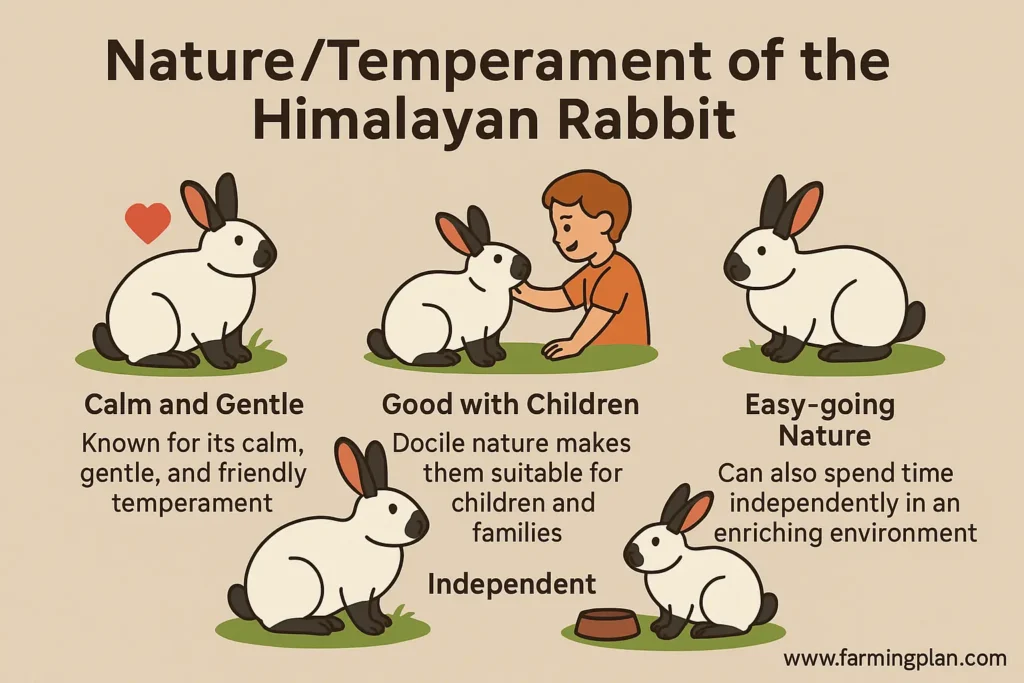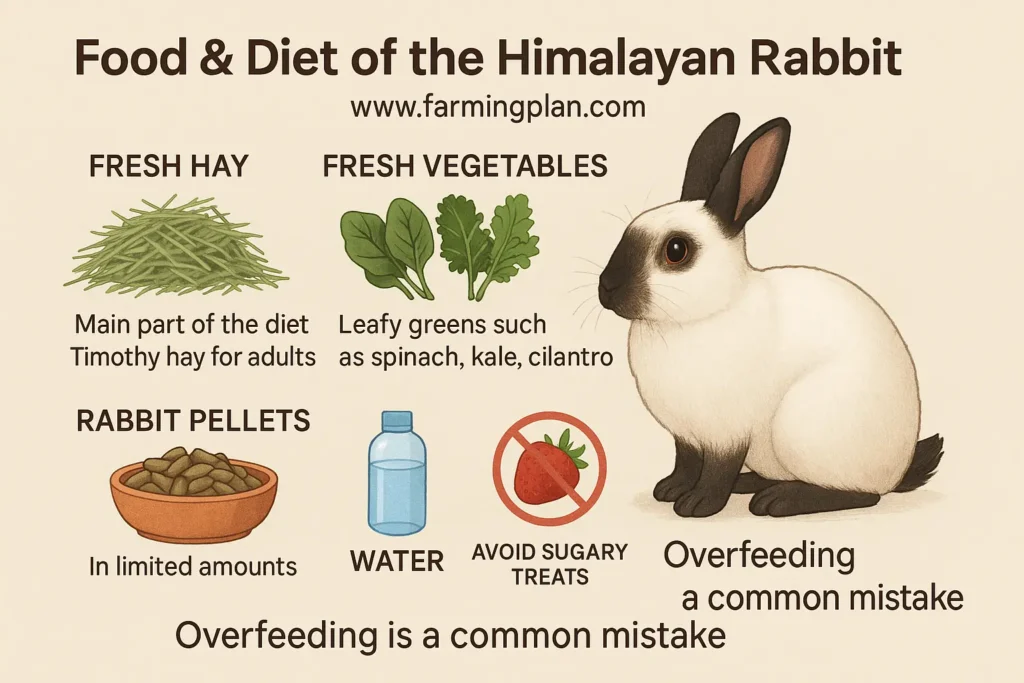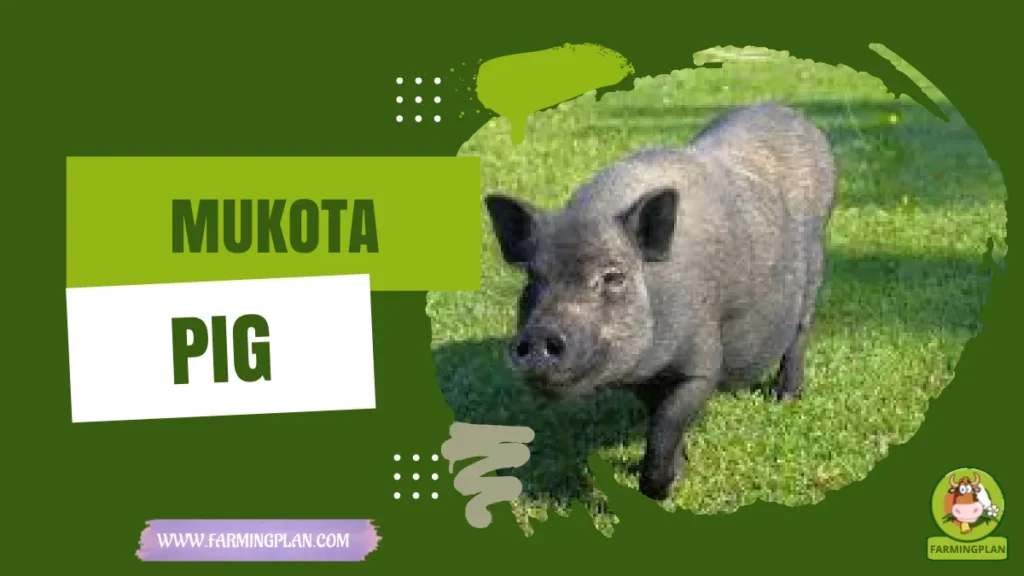The Himalayan rabbit serves as both a well-liked pet and a breeder choice because of its remarkable visual features and its docile nature. The Himalayan rabbit stands out through its unique black-nosed and blue coloration while presenting a relaxed personality which makes it suitable for families starting with rabbit ownership. Rabbit enthusiasts will find the Himalayan rabbit provides attractive appeal together with captivating personality when choosing one as a pet or competitive show participant. This article provides all essential information about the Himalayan rabbit breed including its roots and highlights alongside areas of upkeep and strategies for keeping your Himalayan healthy.

History & Origin of the Himalayan Rabbit
The Himalayan rabbit, a breed with a fascinating history, originated in the late 19th century, primarily in Europe, where it was developed as a cross between the Siamese and other domestic rabbits. This breed is particularly notable for its unique color variations, which are a result of a genetic mutation that causes the darker markings on its ears, nose, feet, and tail, while the rest of the body remains lighter.

Initially, the breed was recognized for its commercial value, including its fur, but over time, it gained popularity as a companion animal. The breed’s distinct color patterns and friendly temperament have made it a favorite among experienced rabbit breeders and as a contender in rabbit shows.
It is often associated with the Californian rabbit breed, which shares a similar history and appearance, making the Himalayan rabbit an essential part of the global rabbit community.
Characteristics of the Himalayan Rabbit
The Himalayan rabbit is easily recognized by its striking appearance, particularly its fur color and markings. Its body is typically light-colored with dark, distinct markings on the ears, nose, feet, and tail, often described as “pointed” coloration. These darker markings can vary in shade, with common colors including black, blue, and brown, though the breed can also have lilac-colored markings. This unique coloration is a result of the breed’s genetic mutation, which causes these markings to appear more prominently on cooler areas of the body.

In terms of body type, the Himalayan rabbit has a cylindrical shape with a medium-sized frame. Their coats are fine and soft, and they require regular grooming to keep them looking their best. These rabbits have an overall compact and symmetrical build, which is ideal for showing in rabbit competitions.
The breed is also known for its calm and docile nature, which contributes to its popularity as a pet. Himalayan rabbits are friendly, social creatures that generally enjoy human interaction, making them suitable for families and first-time rabbit owners. Their gentle temperament makes them an excellent choice for those seeking a rabbit that is easy to handle and bond with.
Nature/Temperament of the Himalayan Rabbit
The Himalayan rabbit is renowned for its calm, gentle, and friendly temperament, making it an ideal pet for both new and experienced rabbit owners. These rabbits are generally affectionate and enjoy spending time with their human companions. Their docile nature means they are often comfortable being handled, making them suitable for children and families. Additionally, Himalayan rabbits tend to get along well with other pets, especially when introduced at an early age.

One of the breed’s most desirable traits is its easy-going nature, which is perfect for individuals looking for a low-maintenance, relaxed pet. They are not overly skittish or prone to aggressive behavior, making them easy to care for and less likely to cause stress for their owners. While they enjoy socializing, they can also spend time independently as long as their environment is enriching and they have plenty of space to roam.
However, like all rabbits, they thrive best in an environment where they feel safe and secure, so it’s important to provide them with a comfortable, quiet space. Their temperament can also be influenced by their upbringing and how much attention and care they receive, so early socialization and consistent handling are key to maintaining their friendly nature.
Read More: English Spot Rabbit: The Charming Bunny That Steals Hearts
Food & Diet of the Himalayan Rabbit
Proper nutrition is essential for the health and well-being of your Himalayan rabbit. A well-balanced diet ensures that your rabbit remains healthy, active, and happy. The primary food for a Himalayan rabbit should be fresh hay, which provides the necessary fiber for digestion and helps prevent obesity and dental problems. Timothy hay, in particular, is an excellent choice for adult rabbits, while young rabbits may benefit from a higher-protein hay, like alfalfa, until they reach adulthood.

In addition to hay, Himalayan rabbits should be fed a small amount of fresh vegetables daily. Leafy greens such as spinach, kale, and cilantro are great choices, but avoid feeding them too many high-oxalate vegetables like spinach, as they can contribute to kidney problems in excess. Fresh, clean water should always be available to your rabbit, as hydration is crucial for their health.
Commercial rabbit pellets can also be included in their diet, but only in moderation. Look for pellets that are high in fiber and free from seeds, nuts, or dried fruits. Avoid giving sugary or processed treats, as these can lead to obesity and other health issues. Remember, overfeeding is a common mistake among rabbit owners, so it’s important to ensure that food portions are appropriate for their size and age.
Lastly, always keep an eye on your rabbit’s body weight and make adjustments to their diet if necessary. A balanced, well-maintained diet will not only keep your Himalayan rabbit healthy but will also help them maintain their beautiful coat and vibrant personality.
Read More: Lionhead Rabbit Care Guide: Raise A Happy, Healthy Bunny
Usage/Purpose of the Himalayan Rabbit
The Himalayan rabbit is a versatile breed, commonly used for several purposes, including as a beloved pet, a competitor in rabbit shows, and historically, for fur production. Due to their calm and friendly nature, Himalayan rabbits are highly regarded as household pets. They are especially popular among families and first-time rabbit owners, as their gentle temperament makes them easy to handle and care for. These rabbits thrive in environments where they can receive plenty of social interaction and care.
In addition to being a popular choice for families, Himalayan rabbits are also highly sought after for rabbit shows. Their distinctive markings and attractive fur coat make them a standout in competitions. Experienced breeders often choose the Himalayan rabbit breed for show purposes because of its symmetrical body shape and beautiful color patterns, which are highly prized in the competitive rabbit world.
While not as commonly used for meat or fur as some other rabbit breeds, Himalayan rabbits have historically been utilized for commercial purposes due to their fine coats. Today, however, they are mostly valued for their companionship and appearance. As such, they have found a place as both a show animal and a friendly household pet, further cementing their status in the world of rabbit breeds.
Read More: Creme d’Argent Rabbit: Guide To Farming
Special Features of the Himalayan Rabbit
The Himalayan rabbit boasts several unique features that set it apart from other rabbit breeds, making it particularly prized among enthusiasts and breeders. One of the most striking characteristics is its distinct color pattern. The breed is known for its darker markings on the ears, nose, feet, and tail, while the rest of the body remains lighter, creating a striking contrast that is the hallmark of the breed. These markings are influenced by a temperature-sensitive gene that causes the cooler parts of the rabbit’s body to develop darker fur.
Another special feature of the Himalayan rabbit is its fine, soft coat. The fur is typically smooth and dense, requiring regular grooming to maintain its pristine condition. This beautiful fur coat not only makes the breed visually appealing but also adds to its popularity as a show animal. The coloration of the coat can vary from black to lilac, blue, and even brown, offering breeders the opportunity to fine-tune offspring colors through selective breeding.
The Himalayan rabbit’s cylindrical body shape is another distinct feature, with a well-balanced, compact build that makes it an ideal candidate for competitive rabbit shows. This breed’s body type, combined with its friendly personality and attractive markings, makes it a favorite among both breeders and pet owners looking for a rabbit that is as charming as it is beautiful.
In addition to these physical traits, the Himalayan rabbit’s calm and docile temperament is another special feature. This breed is known for being easy to handle and social, which makes them excellent companions for families and individuals alike. These special qualities make the Himalayan rabbit a standout breed in the world of domestic rabbits.
Health Issues & Prevention of the Himalayan Rabbit
Like all rabbit breeds, the Himalayan rabbit is prone to certain health issues that require attentive care and prevention. Understanding these potential health concerns can help owners ensure their rabbits live long, healthy lives. One of the most common health issues in Himalayan rabbits is dental problems. Rabbits have constantly growing teeth, and if they do not wear down properly due to improper diet or lack of chewing materials, it can lead to overgrown teeth. Regular access to hay, chew toys, and safe wooden items can help prevent dental issues.
Another concern is respiratory infections, which are common in rabbits due to their sensitive respiratory systems. Symptoms can include nasal discharge, labored breathing, and lethargy. Keeping your Himalayan rabbit’s living space clean and free of drafts, as well as maintaining a proper temperature, is essential for preventing respiratory problems.
Additionally, obesity is a common issue in domestic rabbits, especially when their diet is not properly balanced. Overfeeding high-calorie treats or commercial pellets can lead to weight gain, which puts stress on their joints and can result in serious health issues like arthritis. It’s important to control portions and provide a diet primarily consisting of hay and fresh vegetables to avoid obesity.
Gastrointestinal issues can also affect Himalayan rabbits, particularly if they are fed too much sugary food or not enough fiber. The lack of fiber can lead to GI stasis, a condition where the digestive system slows down or stops altogether, which can be life-threatening. To prevent this, always ensure your rabbit has unlimited access to high-fiber hay, and avoid feeding too many fruits or sugary treats.
Fur and skin health is another area to watch out for. Himalayan rabbits have a beautiful, dense coat that requires regular grooming to prevent matting. Without proper grooming, fur can become matted, which may lead to skin infections or discomfort. Regular brushing helps to maintain their coat and keep their skin healthy.
Lastly, parasites such as mites or fleas can affect Himalayan rabbits, especially if they are housed outdoors. Regular checks for signs of parasites and maintaining a clean living environment can prevent infestations.
Overall, a proper diet, regular grooming, a clean environment, and frequent health checkups are crucial for preventing these common health issues and ensuring the long-term well-being of your Himalayan rabbit.
“A Happy Himalayan Rabbit Starts With A Clean Cage, A Gentle Touch, And A Dash Of Daily Love.”
Step-by-Step Farming Guide/Pet Owner Care Guide
Caring for a Himalayan rabbit requires attention to detail, a proper setup, and consistent care to ensure their health and happiness. Whether you’re raising a Himalayan rabbit as a pet or in a more farming-focused environment, following these steps will help you provide the best care possible for your furry companion.
Setting Up the Living Space
First, it’s important to create a comfortable and safe environment for your Himalayan rabbit. A spacious cage is essential, as it provides room for your rabbit to move around and feel secure. The cage should be at least four times the size of your rabbit when they are fully grown. It should also have proper ventilation and be placed in a cool, dry area to avoid extreme temperatures.
For indoor rabbits, make sure the cage is placed away from direct sunlight, hot vents, or drafty areas. Outdoor rabbits, on the other hand, require an enclosed space with access to shade and protection from predators.
Providing a Balanced Diet
As discussed earlier, the diet is crucial to your rabbit’s well-being. The primary component of their diet should be high-quality hay, such as Timothy hay, which promotes good digestion. Fresh vegetables, including leafy greens like romaine lettuce, spinach, and parsley, should be added daily. Limit fruits to occasional treats, as they are high in sugar. Provide fresh water in a clean bottle or dish at all times, ensuring your rabbit stays hydrated.
Regular Grooming
The Himalayan rabbit’s fur is beautiful but requires regular grooming. Brush your rabbit’s coat at least once a week to prevent matting and to keep it clean and shiny. Regular grooming also helps you keep an eye on their skin and check for parasites, like fleas or mites, that could cause irritation.
Socialization and Interaction
Himalayan rabbits are friendly and enjoy human interaction. Spend time with them daily, and handle them gently to keep them accustomed to human touch. This also helps reinforce their calm and docile temperament, making them even more comfortable around people.
Exercise and Free-Range Time
Rabbits are naturally active and need a lot of space to run around. Even though a cage is required for safety, it’s also important to give your Himalayan rabbit free-range time in a safe, enclosed area. This way, they can run around and satisfy their natural curiosity. You can create a rabbit-proof area in your home or yard where your rabbit can run around freely under supervision.
Monitoring Health
Regular health checks are essential. Watch for any signs of discomfort or illness, such as changes in eating habits, behavior, or appearance. If you notice anything unusual, consult a veterinarian who specializes in rabbits. Scheduling annual checkups will help catch any potential health issues early.
Preparing for Holidays or Absences
If you need to leave for a vacation or any extended period, make sure someone is capable of taking care of your rabbit in your absence. Arrange for a trusted pet sitter who understands the specific care requirements of a rabbit, or consider boarding them at a reputable facility that specializes in rabbit care.
By following these steps and providing a consistent, caring environment, you can ensure your Himalayan rabbit lives a happy and healthy life. Proper care, socialization, and regular attention to their diet and grooming will keep your furry friend thriving for many years to come.
Additionally, it’s a good idea to prepare a care package or handbook for the person looking after your rabbit. Include detailed instructions about their daily routine, dietary preferences, and any special needs or medications. Provide contact information for your veterinarian in case of an emergency.
Familiarize your pet sitter with your rabbit before you leave. Introduce them to your Himalayan rabbit while you are still at home. This not only helps your rabbit get used to the new person but also allows the sitter to ask any questions they might have. Reassuring your rabbit with the sitter present can ease the transition and prevent stress.
Moreover, ensure that your home is rabbit-proofed to avoid any accidents or potential hazards. Rabbits are curious animals and may get into trouble if left unsupervised. Secure all electrical cords, cover potential escape routes, and remove any toxic plants or substances from the area where the rabbit will spend time.
Lastly, leave your sitter with a list of emergency supplies and instructions. Stock up on rabbit food, fresh vegetables, and bedding materials beforehand to ensure they won’t run low while you’re away. By taking these precautionary measures, you can relax knowing your Himalayan rabbit is in good hands and will be well taken care of during your absence.
FAQ
What is the lifespan of a Himalayan Rabbit?
Himalayan Rabbits typically live between 5 to 8 years with proper care. Some may live over 10 years if provided with a balanced diet, regular veterinary check-ups, and a comfortable environment.
Are Himalayan Rabbits good with children?
Yes, their gentle and sociable nature makes them excellent companions for families with children. They enjoy interaction and are easy to handle, provided they are taught how to be handled gently.
What should I feed my Himalayan Rabbit?
Their diet should consist of 70% hay, 25% high-quality rabbit pellets, and 5% fresh vegetables and fruits. Ensure all fresh foods are rabbit-safe and introduce new foods gradually to prevent digestive issues.
Can Himalayan Rabbits be kept outdoors?
While they can be kept outdoors, it’s best to house them indoors to protect them from predators and extreme weather conditions. If kept outside, ensure their enclosure is secure and provides adequate shelter.
How often should I groom my Himalayan Rabbit?
Himalayan Rabbits have short, soft fur that requires minimal grooming. Brushing once a week is usually sufficient, but during shedding periods, increase grooming to two or three times a week to prevent matting.
Conclusion
The Himalayan Rabbit is a calm, affectionate, and low-maintenance breed, making it an ideal companion for families and first-time rabbit owners. With proper care, including a balanced diet, regular grooming, and a safe living environment, these rabbits can thrive and bring joy to their owners for many years. Their gentle temperament and unique appearance make them a standout choice among domestic rabbit breeds.


